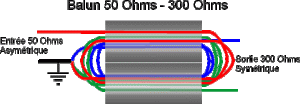Homebrewing a balun
Construction d’un Balun
50 / 300 Ohms
Fonctionnant de 3 Ã 30 MHz
La construction d’un Balun est un travail relativement simple. Il vous est proposé ici la réalisation d’un Balun 50 Ohms asymétrique / 300 Ohms symétrique. Le transfo fait appel à deux tubes ferrite, matériau 43. La taille des tubes va dépendre de la puissance à passer. Les tubes proposés ici sont par exemple deux Fair-Rite, de diamètre exterieur 19mm, interieur 10,5 mm et de longueur 50 mm.
La réalisation d’un Balun nécessite plusieurs enroulements, 3 dans notre cas. Pour définir ce qu’est un enroulement, il est plus simple de l’illustrer par la figure 2.
Le Balun 50 / 300
On commence par faire 2,5 spires (bleu), en partant du coté 300 Ohms. On raccorde l’autre extrémité à la masse, au niveau de la prise d’entrée. Ce sera d’ailleurs le point commun de masse. En partant de la masse, on rebobine à nouveau 2,5 spires de fil (vert) qui aboutira coté 300 ohms. Toujours à partir du point de masse, on rebobine à nouveau 2 spires (rouge) qui aboutira à la prise (PL) d’entrée.
Le diamètre du fil sera choisi de manière à occuper la totalité du tube.
En gardant le même principe, on peut réaliser différentes adaptations en respectant le nombre de spires donné par le tableau suivant :
Adaptation Bleu Vert Rouge
50 / 50 1 1 2
50 / 110 1,5 1,5 2
50 / 200 2 2 2
50 / 300 2,5 2,5 2
50 / 450 3 3 2
50 / 600 3,5 3,5 2
50 / 800 4 4 2
Sur une charge fictive, le TOS que l’on peut relever ne dépasse pas 1,5. Les pertes mesurées sont de 0,4 dB.
Le fil pourra être , suivant la taille soit du fil émaillé, du fil rigide de cablage domestique, du fil souple de cablage industriel.
Exemple de réalisation d’un balun pour antenne de type WINDOM






How about posting the balun plans in English? Thanx Frans.
Hi IW5edi,
Please send 50/300 ohm balun construction in english, and will it do 1500 watts legal limit ?
ur email reply will be great !
tnx, 73,
Harry.
hello simone
please on english i cant read france
jour homebrewing balun site interesting
best regards from sm7nbo
Hello Guys…
use google translator for your translation needs
translate this page
in your language now
Hello:
I need a contrution 6:1 balun 3000W to work 3,5~30Mhz.
Please send me a PDF with instrutions to home made.
Best regards
Jorge-ct1asm
The text reads something like this in English:
The construction of a balun to go from 50 to 300 ohms for frequencies between 3 and 30 MHz.
Constructing a balun is pretty easy. Here’s how to make a balun to turn a 50 ohms unbalanced to 300 ohms balanced. It’s done with two tubes of type 43 ferrite. The size of the tubes depends on the power you want to run. In this example, I’m using two Fair-Rite tubes, with an outside diameter of 19mm, an interior diameter of 10.5mm, and a length of 50mm. (Note for the metric impaired: That’s about 3/4 inch outside, 3/8 inch or so inside, and 2 inches long. I don’t think the precise dimensions are critical.)
This balun requires several coils, three in this case. To illustrate, see figure 2.
Start with 2.5 turns (shown in blue) from one of the 300 ohm terminals and connect the other end of that to the coax outer shield. This will be the common for the balun. Starting from the ground, wind 2.5 more turns (shown in green) and connect that to the other 300 ohm terminal. Also, wind two turns (shown in red) from the ground and connect that to the coax center conductor. (NOTE: The diagram shows all of the windings being wound in the same direction, which matches information about similar baluns that I’ve seen elsewhere.)
The wire diameter is chosen to fill the center of the ferrite tube.
Following the same principle, you can make other impedance transformations by using different numbers of windings, as shown in the table: (NOTE: I won’t reproduce the table, the first number is the unbalanced impedance, the second one is the balanced impedance, the third is the number of turns of blue winding, the number of turns of green winding, and the number of turns of red winding.)
On a dummy load with an SWR of less than 1.5:1, I measured a loss of 0.4 dB.
You can use any kind of wire, enamelled, house wiring, or flexible industrial cable.
Here’s an example of a balun for a Window antenna.